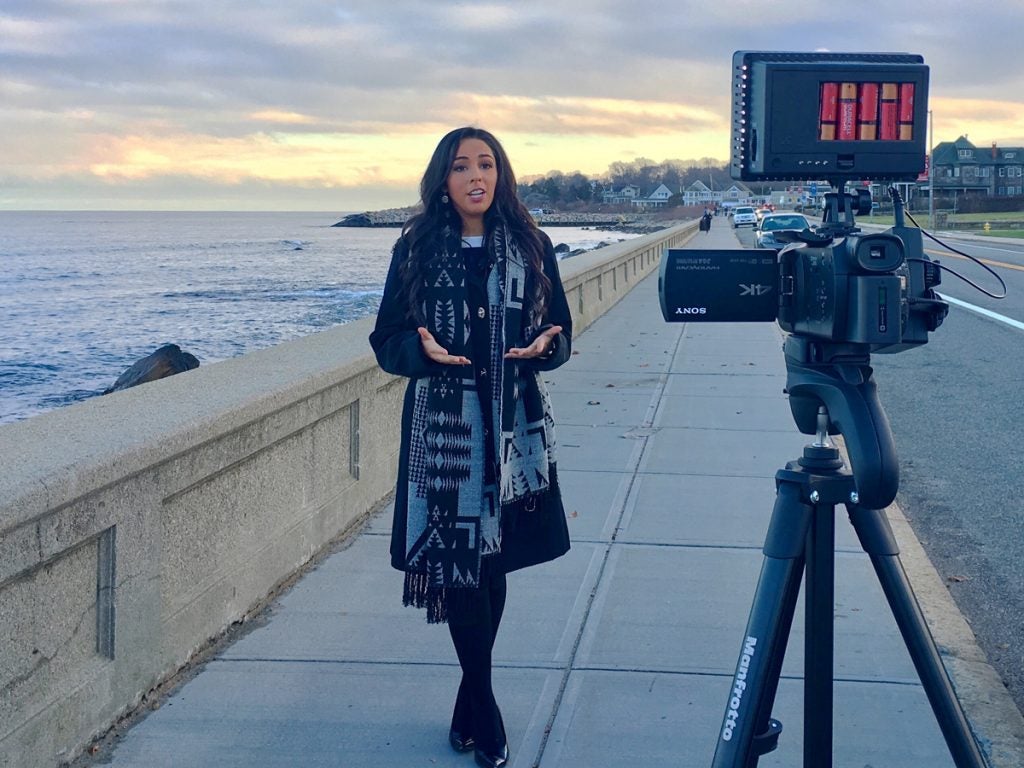
The film footage shows a 5-year-old Marissa Tansino in the biting rain, pink raincoat on, pink umbrella in hand, reporting the news as she stands in the rubble of what had been her grandparents’ concrete wall. Her crew: her dad and his Sony Handycam.
“The wall has fallen down,” Tansino tells her audience. “But nobody got hurt.”
Sixteen years later, Tansino ’17, a journalism major in the Harrington School of Communication and Media, is ready for her first professional gig: multimedia journalist at WMBF News in Myrtle Beach, S.C. In pursuing a journalism career, she joins an illustrious group of alums including Pulitzer Prize-winner Thomas J. Farragher ’77, this weekend’s graduate school commencement speaker; CNN’s Christiane Amanpour ’83 and John King ’85; and Vladimir Duthiers ’91, CBS News correspondent and undergraduate school commencement speaker. Tansino hopes to take her place among them one day with her eye trained on reporting for Boston’s WHDH, the television station she watched when a child.
“My hope is that we have people who want to hear the truth and not just what entertains them. I went into this with an open mind. I know this isn’t easy.”
Tansino talks of her future and the future of journalism with tempered enthusiasm. She enters the profession at a tumultuous time—an era of public mistrust and out-and-out animosity that has given rise to terms such as “fake news,” “alternative facts,” “citizen journalists,” and “dishonest media.” The weight of responsibility that comes with being a journalist is one Tansino is willing to bear. “Journalists right now are faced with a huge obstacle with the emergence of stations that are opinionated and lines that are being blurred.
“People selectively perceive what they want to perceive and it’s scary because people become narrow-minded. My hope is that we have people who want to hear the truth and not just what entertains them,” Tansino said. “I went into this with an open mind. I know this isn’t easy. What I learned confirmed what I already knew about the business.”
The student has learned her lessons well, and the influence of John Pantalone, associate professor of journalism and department chair, is evident in her words.
“There is a path for students who want to do serious reporting,” Pantalone said. “And if the public embraces a renewed sense of the importance of the watchdog role of the journalist then maybe they will support journalism again.”
The obstacles are many for the aspiring journalist. First, there is the issue of money. Salaries start low and sometimes stay low. There is the aforementioned issue of public distrust. Then there is the scope of the work journalists do. Print journalists, for example, are no longer simply charged with writing about the news conference after the fact; they’re expected to Tweet as it’s happening, Pantalone said. URI’s journalism program has taken this in stride: making its journalists also photographers, videographers, filmmakers, broadcasters, editors, and social media strategists.
Uncovering the truth
URI alumnus Tom Farragher ’77 knows first-hand the kind of dexterity and flexibility that’s needed today. A member of the Boston Globe Spotlight Team that won the 2003 Pulitzer Prize for Public Service for its investigative series on the sex abuse scandal involving the Archdiocese of Boston, he noted that such layered work was being done then, too.
Spotlight broke the Boston clergy sex abuse story on January 6, 2002, with the headline “Church allowed abuse by priest for years.” It was to be the first of a two-part story. Instead, it was a watershed event. By the end of that year, Spotlight reporters had written 600 related stories and on December 11, 2002, the head of the Catholic Church in Massachusetts, Cardinal Bernard F. Law, resigned. To do that work required a small army of Globe reporters, editors, researchers, photographers, graphic artists, filmmakers, web editors, designers and lawyers. The Globe had an online presence and a network-quality, feature-length film, Spotlight On Spotlight, accompanying its print stories. The story garnered international attention and Hollywood notice. In 2016, Spotlight, the movie, won the 2016 Oscar for Best Picture.
Glitz and glamor, though, are not the day-to-day experience of the average reporter, Farragher said.
“There’s this Hollywood version of what reporting is, that can be glamorous, this chasing and running down bad guys and that really isn’t what it is. A lot of it is drudgery and shoe-leather reporting. You’re in an office and you’re going through boxes and boxes of documents and then marbled in with that you’re developing sources and trying to get them to tell you things they don’t want to tell you or shouldn’t tell you or they’re risking their jobs if they tell you. That takes time and that takes patience.
“You need to look these people in the eye and make them feel like the public will benefit from the story that will be told.”
It’s important, at times, even heroic work. And in that context, URI’s selection of two award-winning journalists to deliver its undergraduate and graduate commencement addresses seems a hopeful act.
“I don’t shake my fist at the heavens,” Farragher said when asked if he misses the halcyon days of print journalism. Rather, he’s energized. “Those were great days but these are, too. I think the ability to tell our story on so many different platforms is great.
“Good journalism in whatever form it is presented will never go out of style.”
